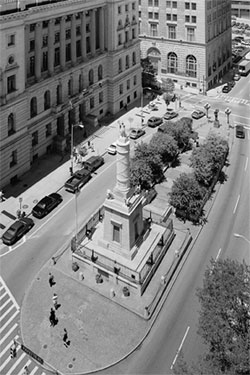Battle Monument Conservation
Intro
The Baltimore Battle Monument Is Extraordinary For Many Reasons:
 It commemorates all thirty-nine Baltimoreans who died in the conflict, regardless of their rank. The friezes present the two battles of the defense: Fort McHenry and North Point.
It commemorates all thirty-nine Baltimoreans who died in the conflict, regardless of their rank. The friezes present the two battles of the defense: Fort McHenry and North Point.- It is considered by some to be the first “Egyptian structure” in America, and its combined use of Egyptian and Classical elements in the design is unusual. The base is particularly Egyptian in its form, with the black doors evoking the quality of a “cenotaph” or sarcophagus. The winged globe on the cornice symbolizes eternity and the flight of time. The column consists of the Classical Roman form of a fasces, or bundle of rods, symbolizing unity.
- This monument is the official emblem of the City of Baltimore, having been adopted for the city seal in 1827. For that reason, the image of the Battle Monument is seen everywhere! (City buildings, signs and printed materials)
- The Battle Monument and the Washington Monument prompted President John Quincy Adams to toast Baltimore “the Monumental City” in 1827. No other American city had such monuments at that time. To this day, and for this reason, Baltimore is known as “the Monumental City.”
Baltimore City’s Commission for Historical & Architectural Preservation (CHAP) is restoring the Battle Monument in preparation for the National “Star Spangled Banner” Bicentennial Celebration beginning in 2012.
The 2011 Battle Monument Conservation Project:
 Steven Tatti and his conservation team at S.A.T. Inc. are completing a restoration project that includes:
Steven Tatti and his conservation team at S.A.T. Inc. are completing a restoration project that includes:
- Casting molds of sculpted works (“Lady Baltimore” and the Griffins). This will create an archival and reproducible record of this historic sculpture before more deterioration causes the sculpture to lose all of its visual clarity. This will offer future generations the option to reproduce these historic pieces so that the originals can be moved to a more environmentally friendly location for their preservation.
- Masonry cleaning and consolidation: Gentle cleaning and poulticing of the friable stone surfaces will even out mottled tone and remove environmental soiling and damaging salts.
- Mortar replacement
- Stone repair: Cracks, patches and resetting
- Flashing at cornice
- Repair to cast iron gate
- Bronze restoration: Plaques, lettering a gate
 About “Lady Baltimore”- The female figure on the top of the monument symbolizes Baltimore. She wears a crown of victory and holds a laurel wreath, a symbol of glory, in her raised hand. Her lowered hand holds a rudder, symbolic of navigation and stability. She faces the harbor, a source of Baltimore’s prosperity and fortune.
About “Lady Baltimore”- The female figure on the top of the monument symbolizes Baltimore. She wears a crown of victory and holds a laurel wreath, a symbol of glory, in her raised hand. Her lowered hand holds a rudder, symbolic of navigation and stability. She faces the harbor, a source of Baltimore’s prosperity and fortune.
Interestingly, her two current arms are “prosthetic” and created by two of Baltimore’s most important sculptors: The reproduced raised arm is the work of Hans Schuler and the reproduced lowered arm is the work of Rueben Kramer. Both original arms had to be replaced due to storm damage and deterioration over many years.
About the architect Maximilian Godefroy (1765-ca. 1838)- The Battle Monument was designed by Maximilian Godefroy, who also designed the St. Mary's Seminary Chapel (1806), the Unitarian Church (1819), a significant and tombs in the Westminster Burial Ground (cemetery where Poe is buried) among other buildings in Baltimore.
 Born in France, Godefroy was the most important architect to work in Baltimore during the first half of the 19th century. He was also a civil engineer and worked on the fortifications at Fort McHenry. It is believed that one reason why he received the Battle Monument commission is that there was a general feeling of guilt that his hard work at Fort McHenry was not properly recognized or compensated. In any case, images his extraordinary war memorial almost immediately appeared upon its completion (Benjamin Tanner’s 1816 engraving) and received publicity nationwide.
Born in France, Godefroy was the most important architect to work in Baltimore during the first half of the 19th century. He was also a civil engineer and worked on the fortifications at Fort McHenry. It is believed that one reason why he received the Battle Monument commission is that there was a general feeling of guilt that his hard work at Fort McHenry was not properly recognized or compensated. In any case, images his extraordinary war memorial almost immediately appeared upon its completion (Benjamin Tanner’s 1816 engraving) and received publicity nationwide.
About the sculptor Antonio Capellano- The sculptured figure on the top of the monument, the griffins, and the two sculptured reliefs on the shaft are by Antonio Capellano, and are among the oldest existing monumental sculptures in the nation. Capellano was a student of Canova and also completed sculpture at First Unitarian and St. Paul’s Churches. Images of conservation above- Courtesy S.A.T.
Contact Kathleen G. Kotarba, Executive Director, CHAP at kathleen.kotarba@baltimorecity.gov(Email Link) for additional information about the Battle Monument and its restoration.
 It commemorates all thirty-nine Baltimoreans who died in the conflict, regardless of their rank. The friezes present the two battles of the defense: Fort McHenry and North Point.
It commemorates all thirty-nine Baltimoreans who died in the conflict, regardless of their rank. The friezes present the two battles of the defense: Fort McHenry and North Point.